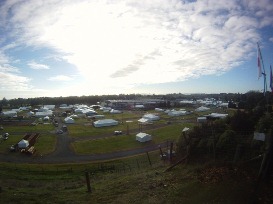New technology to advance weather forecasts for farmers
Scientists give farmers the chance to trial new weather forecasting technology at Fieldays.
There are light southerly winds, it is partly cloudy with a low chance of rainfall, and about 16ºC. The sun peeks through the clouds as Gerald and Claire Bull describe how important weather forecasts are to them. Checking the weather forecast is a daily ritual for the couple who own 400ha across their farms in Ngaruawahia, Northern Hawke’s Bay, and Raglan.

Mr and Mrs Bull live on their Ngaruawahia farm near the outskirts of the rural village that is Glen Massey. Knowing the weather is crucial to the wellbeing of the 1600 ewes on their land. The farmers analyse the weather forecast a week in advance for both their summer and winter shearing seasons. “You take a big risk if you start to go near sheep shearing and do not try to manage it around the weather,” says Mr Bull.
Mr Bull says it is important to be on the top of your game when it comes to shearing time. “You’re changing a sheep’s environment dramatically by taking off its woolly coat,” he says.
Sheep are more susceptible to the cold after losing the warmth of their wool. If they are exposed to excessive or prolonged weather stress, they may lose their ability to maintain a stable body heat, which could result in them dying from hypothermia.
Mrs Bull says the weather forecasts help them manage their time, and their farm operation more efficiently. The farmers use the online Metvuw service to help them choose a sequence of dry days before they call in the shearers. As an extra precaution, they get their shearers to use cover combs, leaving about 14 days of wool on the sheep.
Farmers will have the opportunity to trial future weather forecasting technology at Fieldays. Scientists at The National Institute of Water and Atmospheric Research (Niwa) are developing a tool which will provide farmers with daily up-to-date weather information specific to their land. Niwa will give demonstrations of the forecasting tool at their Fieldays site.
The tool was designed to inform farmers when it is best to irrigate, but scientists hope to expand the project to help with other farming operations such as harvesting, fertilising, and stock movement. It has been trialled for a couple of years in Canterbury by five farmers. Chief scientist of environmental information at Niwa, Jochen Schmidt, says an important part of the project is about getting feedback from farmers to help scientists understand how the product can best meet farmers’ needs.
The tool optimises irrigation for the trial farmers by emailing them daily with information about when it is best to irrigate, how much water to use, and how much water they have available. It provides farmers with two, six, and 14-day forecasts. The information allows farmers to plan water usage based on forecast conditions tailored for their farm.
Niwa is providing a trial of a similar, web-based system to Fieldays visitors. Those interested in trialling the system can sign up during Fieldays. Farmers will then be provided with 24/7 access to the tool.
“We know that a range of farming activities and operations are influenced by weather and we believe we can actually help the farmers save money, increase their economy, and also reduce environmental impact,” says Mr Schmidt.
Niwa will also be demonstrating another weather service, which they will utilise for their role as the official weather forecasting service for Fieldays. The service, called EcoConnect, is currently only used by commercial subscribers, but Niwa scientist Dr Murray Poulter says it could be available for farmers in the future.
Niwa has set up a weather station at Mystery Creek, which is feeding live observations of current temperature, wind speed and direction, and rainfall to display screens across the complex and to Niwa’s Fieldays exhibition site. “Once we’ve received six weeks of observational data from the weather station we will know the microclimate of the site,
and that will help to provide a much more accurate two-day forecast,” Poulter says.
“Mystery Creek does sometimes have a reputation for producing mud, so we might be able to help people decide whether they bring their raincoats and gumboots,” he says.
Niwa released the first official forecast for Fieldays last week, when it said the weather looked promising for the big event. “There are no major rain-bearing weather systems on the horizon at this stage, and computer models suggest that generally dry conditions with light winds should prevail between the 12th and the 15th.
“Maximum temperatures are likely to be around the 14 or 15 degree mark, which is right on average,” says Poulter. He says the forecast could change and visitors are advised to keep an eye on Niwa’s weather feed on Fieldays website for the latest conditions. Farmers will also have the opportunity to trial Niwa’s specialised weather forecasting services and see them in action at their Fieldays site, PF15.




